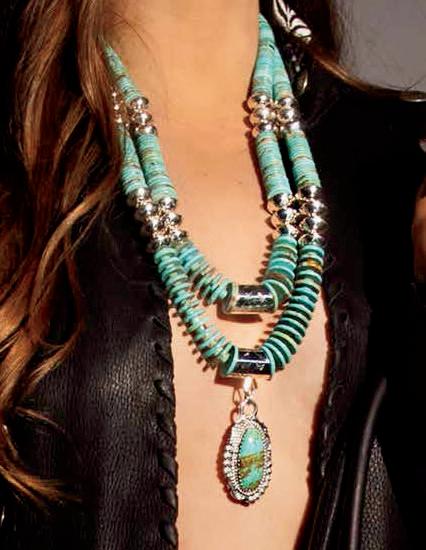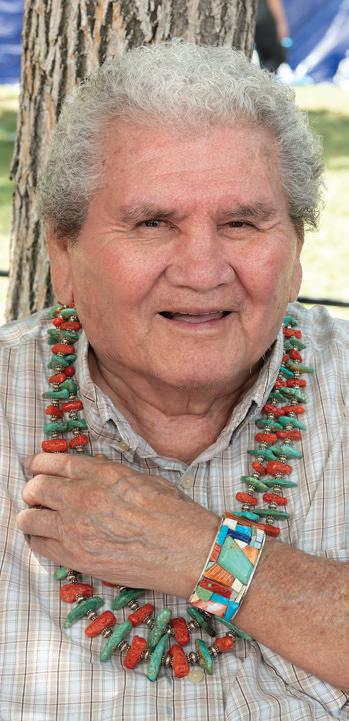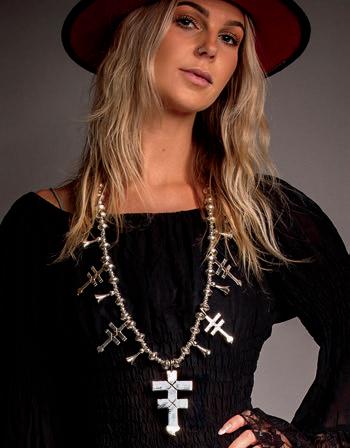
3 minute read
JIMMY (CA’WIN) CALABAZA Traditional Meets Contemporary
A registered tribal member of Santo Domingo Pueblo, Jimmy F. “Ca’Win” Calabaza is well known for his handmade, hand-ground, smooth and polished turquoise beads, as well as his signature “Side Box” necklace and the use of heavy gauge silver in his silversmithing. Ca’Win blends traditional elements of Santo Domingo Puebloan designs in creating contemporary masterpieces.

Advertisement
Art Surrounds a Young Ca’Win Ca’Win has always been around the arts, even as a young child. He learned his family’s artistic techniques by watching his grandfather, Antonio Garcia, grind on sandstone, drill with hand-pump drillers, and polish turquoise using denim blue jeans and animal fat. He has a fond memory of sitting around the fieplace with the other grandchildren while grandfather told stories as he was polishing.
Ca’Win’s grandfather wasn’t the only family artist. His grandmother, Andrea Q. Garcia, made pottery. His mother, Celestina G. Calabaza, was known for her lapidary and inlay work and was a seamstress. Thy all played a part in forming Ca’Win’s artistic journey. He learned the different Santo Domingo art mediums, such as pottery making, jewelry making, bow and arrow making, and leather work, and their techniques as he was growing up. He infused aspects of those techniques into his own style of lapidary and silversmith work.
Th diversity of art surrounding him also taught him that beauty comes in all forms. “I discovered that patience is taught while making art,” he says. “Listening to the piece evolve is its own gift that one learns and begins to understand the innate beauty that each art piece already has.”
Ca’Win Embarks on His Creative Journey
It wasn’t until the early 1980s that Ca’Win began his professional artistic journey, and it became his main source of income. During that time, he added silver into his lapidary work. His silversmithing artform technique was self-taught, because while his father, Lorenzo Calabaza, was a silversmith, an accident impaired his ability to teach him. His father called him to his workshop and told him it was his—the silversmithing table and tools. He then bestowed a blessing to him, saying, “May God bless you to do beautiful work.”



Ca’Win believes that the genesis of his work is his familial lineage. He carries on his family and the voices of his ancestors through his work, documenting his own time and space in this place.
Inspiration for Art
Ca’Win’s pieces reflec iconic Southwestern Native American imagery combined with Christian religious symbols. Some pieces have dual meanings, offering both a Puebloan and Catholic perspective. For example, the cross pictured at right is the Pueblo dragonfl, traditionally carved out of cottonwood. Each Pueblo along the Rio Grande had its own dragonfl design that served as a form of identifiation—if you were lost, others would know which Pueblo you came from. Traditionally, the dragonfl did not have the tip at the bottom. Ca’W in explains that the tip, which resembles a teardrop, was added after the Spanish came to the Southwest territory. “When the Spanish came, there was a lot of persecution, so a teardrop was carved at the bottom to signify pain and suffering.”

Th Spanish brought the art of silversmithing with them, and the Pueblo people learned the art of silversmithing and began making the dragonfl necklace from silver rather than the traditional cottonwood. Later, after the Pueblo people conformed to Catholicism, the necklace took on a second meaning. Th top bar stood for Jesus, the second bar for the man who asked Jesus to remember him, and the teardrop became the sacred heart.

The Legacy Continues
Ca’Win’s children are continuing the legacy with their art forms, infusing their style, families, and ancestors’ techniques in making it their own, providing a continued footprint through art.
His daughter Estefanita (Stephanie) makes jewelry and paints. Daughter Naomi makes jewelry and does silversmithing and beadwork. His son Santiago Jr. does lapidary work, silversmithing, and woodwork. Son Tyson is a silversmith. Son Deon creates art through gourd burning, pottery, silversmithing, and painting. Th art legacy continues to the next generation as Ca’Win’s grandsons, William and Joseph, observe and learn how to use all these art forms.
“We will see what blessing or gift the creator gives them,” says Ca’Win. “What a blessing to know they will continue mine and my family’s voices in their art.”

Art Events are a Family Affair

Ca’Win frequents art events throughout the year, and his family plays a crucial role in each. His sons help with setting up and tearing down the booth, while his wife and daughter are the salespeople. Ca’Win says that all the art seen at the booth during events is his work, although his sons help him polishing the silver.
Ca’Win stepped away from shows during the COVID pandemic but is now planning to do shows again. In addition to NFR and the Santa Fe Indian Market, he plans to do the Vermillion Art Events throughout the season. His work is also on display and for sale through the Gerald Peters Gallery in Santa Fe, NM. He also showcases his work on www.cawinjewelry.com.










